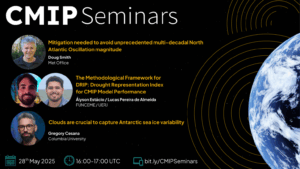Doug Smith Research Fellow, Met Office, UK
Title: Mitigation needed to avoid unprecedented multi-decadal North Atlantic Oscillation magnitude
Abstract: The North Atlantic Oscillation (NAO) dominates winters in Western Europe and eastern North America. Future climate model projections of the NAO are highly uncertain due to both modelled irreducible internal variability and different model responses. Here we show that some of the model spread in multi-decadal NAO simulations is caused by climatological water vapour errors, and develop an emergent constraint that reveals a substantial response of the NAO to volcanic eruptions and greenhouse gases (GHGs). Taking account of the signal-to-noise paradox apparent in these simulations suggests that under the high-emissions scenario the multi-decadal NAO will increase to unprecedented levels that will likely cause severe impacts, including increased flooding and storm damage. This can be avoided through mitigation to reduce GHG emissions. Our results suggest that taking model projections at face value and seeking consensus could leave society unprepared for impending extremes.
multi-decadal NAO simulations is caused by climatological water vapour errors, and develop an emergent constraint that reveals a substantial response of the NAO to volcanic eruptions and greenhouse gases (GHGs). Taking account of the signal-to-noise paradox apparent in these simulations suggests that under the high-emissions scenario the multi-decadal NAO will increase to unprecedented levels that will likely cause severe impacts, including increased flooding and storm damage. This can be avoided through mitigation to reduce GHG emissions. Our results suggest that taking model projections at face value and seeking consensus could leave society unprepared for impending extremes.
Ályson Estácio Water Resource Scientist, FUNCEME, Brazil
Lucas Pereira de Almeida PhD Student, UERJ, Brazil
Title: The Methodological Framework for DRIP: Drought Representation Index for CMIP Model Performance
Abstract: This presentation introduces a methodological framework designed to evaluate the ability of CMIP climate models to simulate drought characteristics. The approach is based on the Drought Representation Index for CMIP Model Performance (DRIP), which assesses models using three key drought parameters—average duration, severity, and return period—by comparing simulated outputs with historical observations. The methodology encompasses four main stages: data acquisition and preparation, drought characterisation, DRIP calculation, and model ensemble generation(E-DRIP). This approach provides a systematic method to identify models that best represent regional drought dynamics and reduce uncertainty in climate projections. By leveraging DRIP as a selection criterion, E-DRIP ensembles outperform traditional CMIP ensembles in both reliability and precision. The method’s flexibility allows adaptation to various drought indices and temporal scales, making it applicable across diverse climatic contexts. Validation in a climatically uncertain area, the Paraíba do Sul River Basin in Southeast Brazil, demonstrates DRIP’s effectiveness in enhancing model performance assessment and improving drought scenario projections. This study contributes a replicable tool for climate modelling, supporting water resources management strategies amid increasing climate variability.
Gregory Cesana Research Scientist, Columbia University, USA
Title: Clouds are crucial to capture Antarctic sea ice variability
Abstract: Models from the Coupled Model Intercomparison Project phase 6 (CMIP6) typically struggle to reproduce observed Antarctic sea ice trends, a bias that is substantially alleviated when constraining winds. We use wind-nudged simulations from two CMIP models to investigate the influence of clouds on sea ice area (SIA). We find that nudging model winds in coupled simulations toward reanalysis, in addition to improving SIA variability, is crucial to reproduce realistic anomalies in cloud radiative effect (CRE) and cloud cover. Biases in the variability of cloud properties at sea ice edge, characterised by CRE anomalies, help explain the remaining discrepancies between simulated and observed SIA; a bias of 1 W/m2 in the CRE anomaly corresponds to a negative bias of 0.43 106km2 in SIA anomaly. Finally, we find that most CMIP6 models show positive trends in CRE anomaly biases, which should contribute to enhanced SIA decline, a long-standing bias in CMIP models.


